Real-time monitoring with AI in data centers has emerged as a game-changer, revolutionizing the way these critical facilities are managed. By harnessing the power of AI, data center environments can be dynamically optimized, ensuring the efficient management of cooling units to align with the workload they are serving. AI enables the fine-tuning of cooling efforts, reducing the speed of lightly loaded units and increasing the performance of heavily loaded units, leading to optimal efficiency.
But the benefits don't end there. AI also empowers constant monitoring and rapid detection of cooling issues, guaranteeing proper temperature maintenance without incurring excessive cooling costs. The integration of AI into real-time monitoring in data centers enhances operational efficiency, cuts down on expenses, and significantly improves overall performance.
But what specific AI-powered solutions and algorithms are involved in this process? How does AI impact data center scalability and flexibility? And what does the future hold for real-time monitoring with AI in data centers?
Let's explore these questions further as we delve into the exciting world of AI-driven data center monitoring.
Key Takeaways
- AI-optimized hardware and algorithms enable real-time monitoring and dynamic optimization of data center environments.
- Real-time monitoring allows for timely detection and resolution of issues, enhancing operational efficiency.
- AI algorithms enable predictive analytics, identifying potential issues and taking proactive measures.
- AI-driven monitoring and management enhance data center security by detecting anomalies and potential breaches.
AI-Optimized Hardware for Real-Time Monitoring
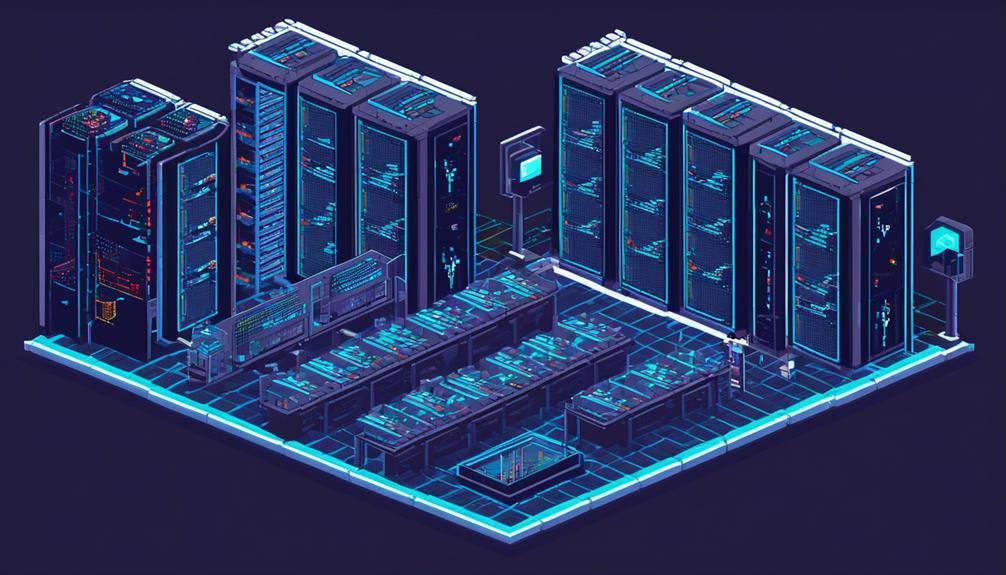
AI-optimized hardware empowers data centers to achieve real-time monitoring and dynamic optimization of their environments, ensuring efficient operation and reduced energy wastage through intuitive management of cooling units. With the integration of AI, data centers can continuously monitor their systems and make adjustments in real-time to improve performance and energy efficiency.
Real-time monitoring is critical in data centers as it allows for the timely detection and resolution of any issues that may arise. AI-optimized hardware enables data centers to collect and analyze real-time metrics, such as temperature, humidity, and power consumption, providing valuable insights into the overall health and efficiency of the environment. This allows data center operators to proactively address any potential bottlenecks or inefficiencies before they escalate into major problems.
AI-optimized hardware also plays a crucial role in resource allocation within data centers. By constantly monitoring the workload and cooling requirements of individual units, AI algorithms can dynamically adjust the speed and effort of cooling units to match the load they are serving. This means that lightly loaded units can operate at a reduced speed, saving energy, while heavily loaded units can receive extra cooling to prevent overheating. This intelligent management of cooling resources not only improves energy efficiency but also extends the lifespan of the cooling units by reducing wear and tear.
Furthermore, AI-optimized hardware facilitates the tracking of real power draw of individual data processing units. By accurately measuring the power consumption of each unit, data centers can identify any sub-optimal equipment performance and take corrective actions, such as replacing or upgrading inefficient components. This level of granularity in power monitoring helps data centers maximize their energy efficiency and minimize unnecessary power wastage.
Benefits of AI in Data Center Monitoring
The implementation of AI in data center monitoring offers numerous benefits, including improved performance, cost optimization, and streamlined operations through the dynamic optimization of power and cooling systems. AI technology enables real-time monitoring and management of data center environments, leading to enhanced operational efficiency. By intelligently optimizing cooling units to match the load they are serving, AI ensures optimal efficiency in data center cooling systems. This is achieved by reducing the speed of lightly loaded units and increasing the effort of heavily loaded units, resulting in efficient cooling without excessive energy consumption.
One of the key advantages of AI in data center monitoring is its ability to constantly monitor and quickly notify operators of any cooling issues. This allows for prompt action to be taken to maintain proper temperature levels, preventing equipment failures and minimizing downtime. AI's real-time monitoring capabilities also enable accurate future planning by providing data center operators with insights into equipment efficiency and capacity utilization.
The benefits of AI in data center monitoring can be summarized in the following table:
| Benefits of AI in Data Center Monitoring |
|---|
| Improved Performance |
| Cost Optimization |
| Streamlined Operations |
| Real-time Equipment Efficiency |
| Accurate Future Planning |
AI-Powered Infrastructure Management Solutions
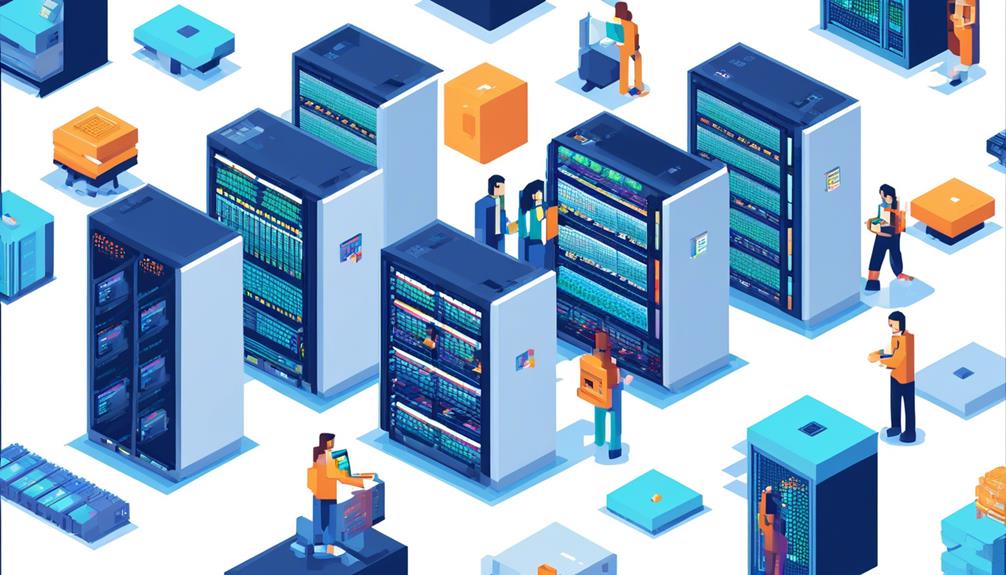
AI-powered infrastructure management solutions revolutionize the way data centers operate by utilizing advanced algorithms and automation to optimize performance and streamline operations. These solutions have several benefits that make them essential for efficient data center management:
- Real-time monitoring: AI-powered infrastructure management solutions provide continuous real-time monitoring of various data center components, including servers, storage systems, and networking equipment. This allows for proactive identification and resolution of potential issues, minimizing downtime and ensuring optimal performance.
- Enhanced efficiency: By leveraging AI, data centers can optimize resource allocation and utilization. AI algorithms can analyze data center workloads and dynamically allocate resources based on demand, ensuring efficient utilization of servers, storage, and networking infrastructure.
- Predictive maintenance: AI-powered solutions can detect patterns and anomalies in data center equipment performance, enabling predictive maintenance. By analyzing historical data and monitoring real-time parameters, these solutions can identify potential failures before they occur, reducing the risk of unplanned downtime.
- Cost optimization: AI algorithms can optimize data center operations to minimize energy consumption and reduce costs. By dynamically adjusting cooling and power distribution based on workload and environmental conditions, AI-powered solutions can deliver significant energy savings while maintaining optimal performance.
- Scalability and flexibility: AI-powered infrastructure management solutions can easily scale to accommodate the growing needs of data centers. These solutions are designed to handle large volumes of data and can adapt to changing requirements, ensuring the smooth operation of data centers as they expand.
Real-Time Monitoring With AI Algorithms
Real-time monitoring in data centers is crucial for maintaining optimal performance and efficiency.
AI algorithms play a significant role in enabling this monitoring by continuously analyzing the data and providing quick notifications of any issues that may arise.
These algorithms allow for intuitive management of cooling units, optimizing power consumption and reducing energy waste.
AI in Data Centers
Utilizing advanced artificial intelligence algorithms, data centers are able to achieve real-time monitoring and optimization for enhanced performance, cost-efficiency, and operational effectiveness. AI in data centers plays a crucial role in managing the complex data center infrastructure, including power usage and cooling systems.
Here are some key ways AI is transforming data centers:
- Real-time monitoring: AI enables data centers to continuously monitor and analyze various parameters in real-time, allowing for proactive identification and resolution of issues.
- Predictive maintenance capabilities: AI algorithms can analyze data from multiple sources to predict when equipment might fail, enabling proactive maintenance and minimizing downtime.
- Power usage optimization: AI algorithms optimize power distribution and usage, ensuring that energy is efficiently allocated and reducing unnecessary consumption.
- Cooling systems management: AI allows for intelligent management of cooling units, adjusting their operation based on the load they are serving, leading to improved efficiency.
- Identification of sub-optimal performance: AI-powered power monitoring helps identify equipment that is not performing optimally, enabling data centers to take corrective actions.
Real-Time Monitoring Benefits
With the integration of advanced artificial intelligence algorithms, data centers are able to achieve dynamic optimization and intuitive management, resulting in improved performance, cost-efficiency, and operational effectiveness.
Real-time monitoring with AI algorithms provides several benefits for data centers. Firstly, it enables the collection and analysis of real-time data and metrics, allowing for proactive decision-making and immediate response to potential issues. AI algorithms can monitor various parameters such as temperature, humidity, power consumption, and cooling efficiency, ensuring optimal conditions for equipment operation.
This real-time monitoring helps identify abnormalities and potential failures, enabling predictive maintenance and reducing downtime. Additionally, AI algorithms can dynamically adjust cooling units to match the load they are serving, reducing energy waste and improving efficiency. Furthermore, AI-driven real-time monitoring allows for better resource allocation and energy optimization by adjusting the speed and effort of units based on their load.
AI Algorithm Applications
AI algorithms play a crucial role in monitoring and optimizing data center environments in real time. These algorithms enable data center operators to make informed decisions based on real-time data and predictive analytics.
The applications of AI algorithms in real-time monitoring are diverse and impactful. Here are five key areas where AI algorithms are making a difference in data centers:
- Predictive analytics: AI algorithms analyze real-time data to identify trends and patterns, enabling data center operators to predict potential issues and take proactive measures.
- Workload management: AI algorithms optimize the distribution of computing resources based on real-time metrics and historical data, ensuring efficient workload management.
- Resource management: AI algorithms monitor power usage, optimizing resource allocation and minimizing energy consumption.
- Automation: AI-driven automation streamlines operations, reducing human intervention and freeing up staff for more strategic tasks.
- Security: AI algorithms enhance data center security by detecting anomalies and potential breaches, enabling prompt actions to mitigate risks.
AI's Impact on Data Center Efficiency
Data center efficiency is significantly enhanced through the implementation of artificial intelligence technology. AI algorithms play a crucial role in optimizing power and cooling in data centers, resulting in improved performance, reduced costs, and more efficient operation.
One of the key areas where AI has a significant impact is in predictive maintenance. By analyzing vast amounts of data, machine learning algorithms can identify patterns and anomalies, allowing data center operators to proactively address potential issues before they become critical. This not only minimizes the risk of downtime but also helps to optimize energy efficiency by ensuring that equipment is operating at its peak performance.
Furthermore, AI enables real-time dynamic optimization of data center environments. By continuously monitoring and analyzing data from various sensors, AI algorithms can make intelligent decisions to adjust cooling units based on the load they are serving. This intuitive management of cooling units ensures that the resources are efficiently utilized, reducing energy consumption and lowering operational costs.
AI algorithms also enable the balancing act of cooling units to obtain optimal efficiency. By dynamically adjusting the speed of lightly loaded units and increasing the effort of heavily loaded units, AI ensures that cooling resources are allocated where they are most needed. This fine-tuning of cooling operations not only maximizes energy efficiency but also extends the lifespan of cooling equipment.
Advanced Data Center Monitoring With AI

The implementation of artificial intelligence technology in data centers allows for advanced monitoring and optimization of critical systems and resources. With AI-powered real-time monitoring, data centers can achieve higher levels of efficiency and performance.
Here are some key benefits of advanced data center monitoring with AI:
- Real-time monitoring: AI enables continuous monitoring of various parameters such as temperature, humidity, and power consumption in data centers. This ensures that any deviations from optimal conditions are detected immediately, allowing for prompt action to be taken.
- Predictive maintenance: AI algorithms can analyze large amounts of data to identify patterns and trends that indicate potential equipment failures. By predicting maintenance needs before they become critical issues, data center operators can avoid costly downtime and optimize resource utilization.
- Energy efficiency: AI can optimize power and cooling systems in data centers, leading to improved energy efficiency. By dynamically adjusting cooling units based on the load they are serving, AI ensures that units operate at their optimal efficiency levels. This not only reduces energy consumption but also lowers operational costs.
- Enhanced resource allocation: With AI, data center operators can intelligently manage and allocate resources, such as server capacity and storage, based on real-time demand. This allows for efficient utilization of resources and improved overall performance.
- Accurate future planning: AI-powered data center monitoring provides valuable insights and analytics that can inform future planning and decision-making. By analyzing historical data and trends, AI can help data center operators make informed decisions about capacity expansion, equipment upgrades, and resource allocation.
AI-Driven Predictive Maintenance in Data Centers
Utilizing real-time data and machine learning, predictive maintenance in data centers driven by AI anticipates equipment failures and optimizes maintenance schedules. By analyzing historical data and real-time metrics, AI algorithms can identify patterns and indicators that precede equipment failures, enabling proactive maintenance actions to be taken. This approach helps to prevent unexpected downtime, reduce repair costs, and extend the lifespan of critical assets.
Predictive maintenance in data centers is particularly important due to the criticality of their operations and the high value of the equipment housed within them. By continuously monitoring various parameters, such as temperature, humidity, power consumption, and performance metrics, AI-powered systems can detect anomalies and identify potential issues before they escalate into major failures. This real-time monitoring allows for immediate action to be taken, minimizing the impact on operations and ensuring the smooth functioning of the data center.
Additionally, AI-driven predictive maintenance contributes to energy efficiency and resource optimization in data centers. By analyzing data on energy consumption and equipment performance, AI algorithms can identify opportunities for optimization, such as adjusting cooling systems or redistributing workloads to more efficient servers. This not only reduces energy wastage but also helps to lower operational costs and promote sustainability.
Enhancing Data Center Security With AI
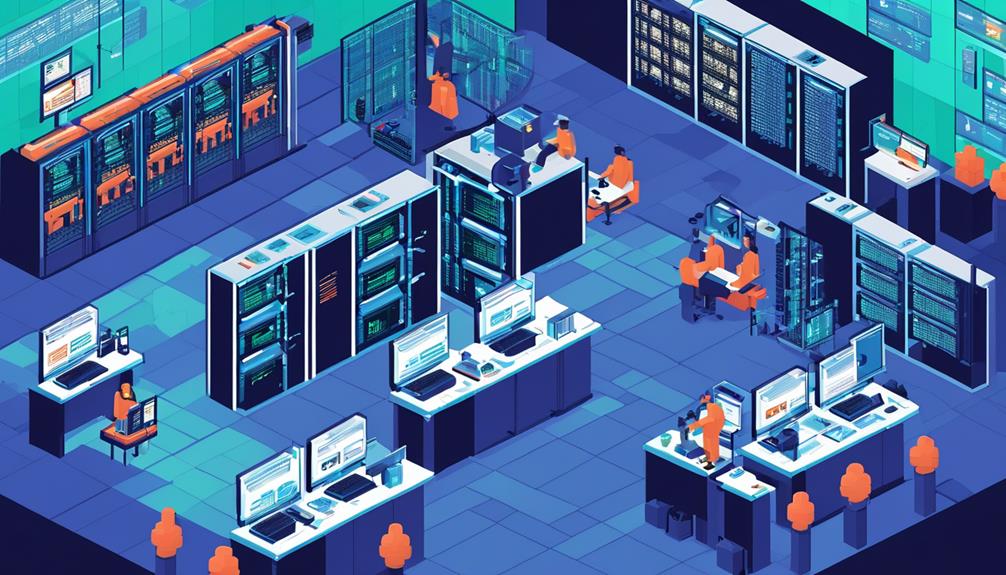
With its ability to detect anomalies in network traffic, access logs, and system behavior, AI plays a crucial role in enhancing the security of data centers. By implementing AI-driven real-time monitoring, data centers can proactively identify potential threats and vulnerabilities, ensuring the protection of business-critical uptime, reliability, and data integrity.
Here are five ways in which AI enhances data center security:
- Anomaly Detection: AI algorithms can analyze large volumes of network traffic, access logs, and system behavior to identify abnormal patterns or activities that may indicate a security breach. This enables data centers to take immediate action and mitigate the impact of potential cyber threats.
- Predictive Security Measures: With AI, data centers can predict potential security threats by analyzing historical data and identifying patterns or indicators of compromise. By leveraging machine learning techniques, AI can proactively identify vulnerabilities and recommend security measures to prevent attacks.
- Improved Data Processing and Storage: AI techniques such as compression algorithms and data encryption enhance the security of data processing and storage in data centers. These techniques ensure that sensitive information is protected from unauthorized access or data breaches.
- Automated Incident Response: AI-powered security systems can automate incident response processes, enabling data centers to respond quickly and effectively to security incidents. By integrating AI with security incident and event management systems, data centers can streamline incident detection, analysis, and response.
- Adaptive Security: AI can continuously learn and adapt to evolving cyber threats, making data centers more resilient against new and sophisticated attack vectors. By analyzing threat intelligence feeds and staying updated with the latest security trends, AI can help data centers stay ahead of potential threats and proactively enhance their security posture.
AI-Enabled Workload Management in Data Centers
AI-enabled workload management in data centers is crucial for optimizing performance and resource allocation in real time.
With AI, workload optimization ensures that computing resources are allocated efficiently and dynamically, based on real-time demands.
Additionally, intelligent capacity planning enables data center operators to accurately anticipate future resource requirements, resulting in improved operational efficiency and cost savings.
AI Workload Optimization
The dynamic optimization of data center environments for improved performance, cost, and operation is made possible through the integration of AI technology. AI workload optimization in data centers involves several key aspects:
- Real-time monitoring: AI enables continuous monitoring of data center operations, allowing for immediate identification of workload imbalances and performance bottlenecks.
- Workload optimization: AI algorithms analyze the workload distribution across servers and dynamically adjust resource allocation to ensure optimal utilization and efficiency.
- Predictive maintenance: AI can predict potential failures or issues within data center equipment, enabling proactive maintenance to prevent downtime and optimize operational efficiency.
- Energy efficiency: AI allows for intuitive management of cooling units to match the load they are serving, reducing energy waste and improving efficiency.
- Cost savings: AI adoption leads to increased benefits for data center operators and customers, enabling real-time equipment efficiency maintenance and accurate future planning.
Real-Time Resource Allocation
Real-time resource allocation in data centers is facilitated by the integration of AI technology. This integration allows for dynamic optimization of workload management. AI enables real-time monitoring of data centers, providing valuable insights into the current state of the infrastructure.
By continuously analyzing real-time metrics, AI algorithms can allocate resources efficiently based on the workload demands and environmental factors. For example, AI can dynamically adjust the cooling units to match the load they are serving. This reduces energy waste and minimizes the environmental impact of data centers.
Furthermore, AI can optimize power consumption by tracking the real power draw of individual processing units. This leads to improved energy efficiency and lower operational costs.
With AI-enabled real-time resource allocation, data centers can achieve optimal performance and cost-effectiveness while maintaining a sustainable and efficient operation.
Intelligent Capacity Planning
With the integration of AI technology, data centers can achieve intelligent capacity planning, enabling efficient workload management and optimization of resources. AI provides real-time monitoring and predictive maintenance capabilities, allowing data center operators to proactively identify and address potential issues before they impact performance. This ensures optimal resource utilization and minimizes downtime.
Here are five key benefits of AI-enabled intelligent capacity planning in data centers:
- Enhanced performance: AI algorithms can analyze data from various sources and make intelligent decisions to allocate resources effectively, ensuring smooth and uninterrupted operation.
- Cost reduction: By accurately predicting resource requirements, AI enables data centers to optimize their infrastructure, reducing unnecessary expenses and improving overall cost efficiency.
- Energy efficiency: AI can intelligently manage cooling units based on load demands, reducing energy waste and costs while maintaining optimal temperature and humidity levels.
- Increased reliability: AI algorithms can detect anomalies and patterns in data center operations, enabling proactive maintenance and minimizing the risk of equipment failures.
- Scalability: AI-enabled capacity planning allows data centers to scale their resources seamlessly, adapting to changing workloads and future growth.
Real-Time Data Analytics With AI in Data Centers
Utilizing artificial intelligence, real-time data analytics revolutionize the optimization, cost-efficiency, and operational performance of data centers. AI enables data centers to analyze vast amounts of real-time data and extract valuable insights to make informed decisions. Real-time monitoring combined with AI algorithms allows for proactive management and predictive maintenance, ensuring optimal performance and reducing downtime.
One key application of real-time data analytics with AI in data centers is the management of cooling units. AI algorithms can intuitively adjust the cooling units' settings based on the load they are serving, thereby reducing energy waste and costs. By continuously monitoring temperature and humidity levels, AI can dynamically optimize the cooling infrastructure, ensuring an ideal environment for the servers while minimizing energy consumption.
Moreover, AI-powered real-time data analytics help identify sub-optimal equipment performance. By monitoring power consumption in real-time, AI algorithms can detect anomalies and identify potential areas for improvement. This enables data center operators to address inefficiencies promptly, leading to improved equipment efficiency and reduced operational costs.
Additionally, real-time data analytics with AI in data centers enable accurate future planning. By analyzing historical data and trends, AI algorithms can predict future capacity requirements, allowing data center operators to proactively allocate resources and optimize infrastructure. This not only ensures smooth operations but also helps in maximizing the utilization of resources, reducing costs, and avoiding unexpected capacity constraints.
AI for Improved Resource Allocation in Data Centers
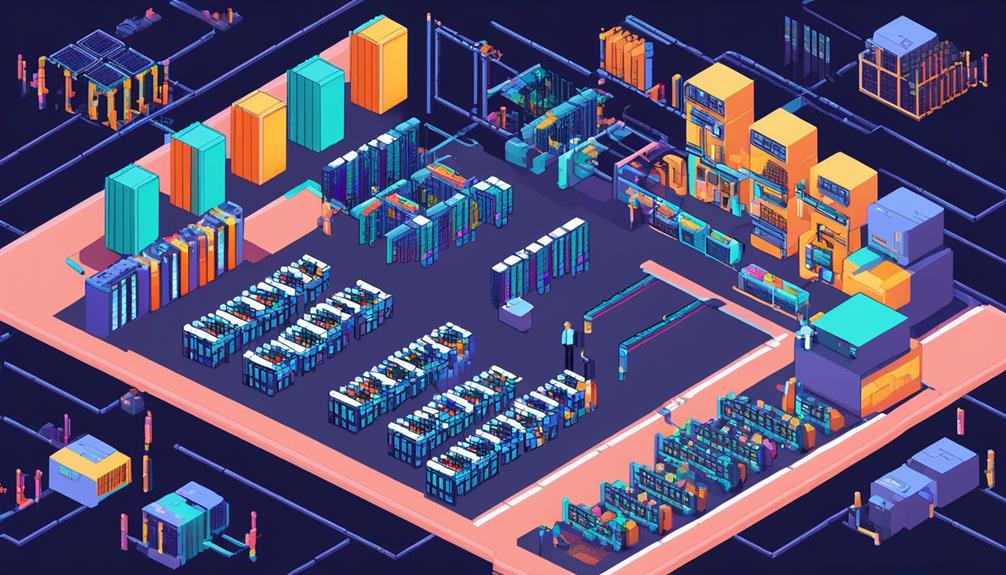
AI plays a crucial role in improving resource allocation in data centers. It does this by enabling efficient server utilization, optimal energy consumption, and dynamic workload allocation. With AI-powered algorithms, data centers can analyze real-time data to identify underutilized servers. This allows them to allocate workloads more effectively, reducing wastage and maximizing server capacity.
Another way AI helps is by optimizing energy consumption. It does this by intelligently managing cooling units and adjusting their workload based on demand. This leads to cost savings and improved operational efficiency in data centers.
Efficient Server Utilization
Efficient resource allocation in data centers can be significantly enhanced through the dynamic optimization of server utilization using AI technology. By leveraging real-time monitoring and AI capabilities, data centers can achieve more efficient server utilization, leading to improved resource allocation and cost savings.
Here are five key advantages of AI-driven efficient server utilization in data centers:
- Intuitive management: AI enables intuitive management of server resources, ensuring they are matched to the demand they are serving. This reduces wastage and improves overall efficiency.
- Real-time analysis: AI can analyze real-time data to identify trends and patterns in server usage. This allows for optimized power distribution and workload management, further improving efficiency.
- Predictive capabilities: Through predictive analytics and machine learning, AI can anticipate future resource demands. This enables data centers to adjust server operations proactively, avoiding potential bottlenecks and ensuring optimal resource allocation.
- Automation: AI-driven automation streamlines server management, freeing up human staff from mundane tasks. This not only improves efficiency but also reduces operational costs.
- Cost savings: With efficient server utilization, data centers can minimize energy consumption, leading to significant cost savings.
Optimal Energy Consumption
Optimal energy consumption in data centers can be achieved through the utilization of AI technology for improved resource allocation.
AI enables real-time monitoring and analysis of data center operations, allowing for dynamic optimization of energy usage.
By continuously monitoring real-time metrics such as server load, temperature, and humidity, AI can intelligently allocate resources to ensure optimal performance and energy efficiency.
AI algorithms can adjust cooling units based on the load they are serving, reducing energy waste and lowering environmental impact.
Additionally, AI can optimize the speed and effort of different units based on their workload, improving operational efficiency and reducing costs.
Furthermore, AI-powered predictive maintenance can identify potential breakdowns or performance reductions, increasing the lifespan of critical equipment and resources.
Through real-time monitoring and AI-driven resource allocation, data centers can achieve optimal energy consumption and performance.
Dynamic Workload Allocation
What is the role of dynamic workload allocation in improving resource allocation in data centers?
Dynamic workload allocation, enabled by AI, plays a crucial role in optimizing resource allocation and improving performance in data centers. Here's why it is essential:
- Real-time monitoring: Dynamic workload allocation allows for continuous monitoring of workload patterns, enabling data centers to efficiently allocate resources as demands change.
- AI-powered optimization: By leveraging AI, data centers can intelligently distribute workloads, ensuring the efficient use of computing resources and optimizing energy consumption.
- Improved efficiency: With dynamic workload allocation, data centers can allocate resources based on specific computational needs, leading to improved efficiency and overall performance.
- Real-time adjustments: AI enables data centers to dynamically adjust computing resources in real-time, ensuring that resources are allocated optimally as workload demands fluctuate.
- Data optimization: Dynamic workload allocation helps data centers optimize data processing, ensuring that the right resources are allocated to each workload, resulting in faster and more accurate data processing.
Dynamic workload allocation, driven by AI, empowers data centers to optimize resource allocation, enhance efficiency, and improve overall performance.
AI's Role in Data Center Scalability and Flexibility
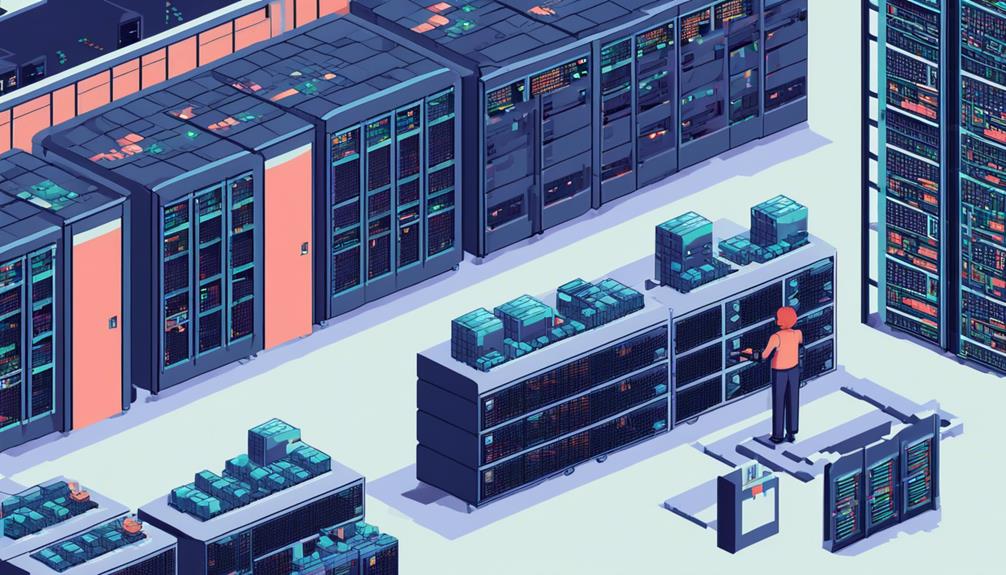
AI plays a crucial role in enhancing scalability and flexibility in data centers through its ability to optimize resource distribution and dynamically adjust infrastructure based on real-time metrics and historical data. By leveraging AI algorithms, data centers can effectively monitor and predict daily workload patterns, allowing them to adjust their infrastructure as needed, providing increased flexibility. This enables data centers to respond to sudden demand increases and shifts in workloads without compromising performance or incurring additional costs.
One key way that AI enhances scalability and flexibility in data centers is through efficient resource allocation. AI-driven algorithms analyze real-time metrics and historical data to allocate resources more effectively, including network bandwidth and server capacity. This ensures that data centers can meet changing demands while minimizing waste and maximizing efficiency.
To further illustrate the role of AI in data center scalability and flexibility, the following table showcases some of the specific benefits provided by AI-driven real-time monitoring:
| Benefits of AI-driven Real-Time Monitoring |
|---|
| Improved resource distribution based on real-time data |
| Dynamic infrastructure adjustments |
| Efficient allocation of network bandwidth and server capacity |
| Ability to respond to sudden demand increases |
| Adaptability to changing workloads without compromising performance |
AI-driven automation also plays a significant role in enhancing scalability and flexibility in data center management. By automating routine tasks and processes, data centers can streamline their operations and adapt to changing demands more efficiently. This not only increases scalability but also allows for greater flexibility in managing resources and workloads.
AI-Driven Energy Optimization in Data Centers
Enhancing the efficiency and sustainability of data centers, AI-driven energy optimization techniques revolutionize the management of power and cooling resources, ensuring optimal performance while minimizing energy consumption. With real-time monitoring capabilities, AI enables dynamic optimization of power and cooling in data centers, leading to significant energy savings and reduced environmental impact.
Here are some key ways in which AI-driven energy optimization is transforming data center operations:
- Intuitive management of cooling units: AI allows for the intuitive management of cooling units to match the load they are serving. By analyzing real-time data and adjusting the cooling capacity accordingly, AI ensures that energy is only consumed as needed, minimizing wastage.
- Load-based optimization: AI can reduce the speed of lightly loaded units and increase the effort of heavily loaded units for energy optimization. This load-based optimization ensures that cooling resources are efficiently allocated, resulting in improved energy efficiency.
- Balancing act of cooling units: AI enables the balancing act of cooling units to obtain optimal efficiency in data centers. By intelligently distributing the workload across multiple units, AI ensures that the cooling resources are utilized effectively, reducing energy consumption.
- Proper temperature maintenance: AI ensures proper temperature maintenance without excessive cooling costs in data centers. By continuously monitoring the temperature and adjusting cooling resources in real time, AI prevents overheating while minimizing energy usage.
- Predictive analytics: AI-driven energy optimization techniques leverage predictive analytics to anticipate future cooling requirements based on historical data and trends. This proactive approach allows data center operators to optimize energy usage and cooling resources ahead of time, ensuring efficient operations.
The Future of Real-Time Monitoring: AI in Data Centers

As data centers continue to evolve, the future of real-time monitoring lies in the integration of AI. By harnessing the power of AI, data centers can achieve enhanced efficiency and optimization.
AI-driven monitoring systems enable continuous evaluation, automated detection of anomalies, and intuitive management of resources, ultimately leading to improved performance, reduced energy waste, and heightened security.
The incorporation of AI in real-time monitoring is poised to revolutionize data center operations and pave the way for increased efficiency and sustainability.
AI Benefits in Monitoring
Real-time monitoring in data centers is revolutionized by the integration of artificial intelligence, allowing for dynamic optimization of performance, cost, and operation. The benefits of AI in monitoring data centers are numerous and impactful.
- AI enables intuitive management of cooling units, reducing unnecessary energy consumption by matching the load they are serving.
- AI ensures proper temperature maintenance without excessive cooling costs through constant monitoring and quick notification of cooling issues.
- AI adoption leads to increased benefits for data center operators and customers, improving data center performance and enabling accurate future planning.
- AI models and predictive maintenance techniques optimize equipment maintenance, ensuring efficient real-time operations and reducing downtime.
- AI enhances security measures in data centers by collaborating with human operators, enabling robust threat detection and response.
Enhanced Data Center Efficiency
The integration of artificial intelligence in data centers has paved the way for enhanced efficiency, particularly in the realm of real-time monitoring, revolutionizing the optimization of performance, cost, and operation.
AI in data centers enables predictive maintenance, ensuring that potential issues are identified and addressed before they can cause significant disruptions. This proactive approach minimizes downtime and maximizes the lifespan of critical equipment.
Additionally, AI enables data center management systems to dynamically adjust cooling units based on real-time metrics, reducing energy waste and improving overall energy efficiency. By matching the workload with the appropriate cooling capacity, AI not only reduces cooling costs but also lowers the environmental impact.
AI in data centers considers various factors, such as outside temperature and humidity, to maintain optimal temperature conditions without excessive cooling.
As a result, AI adoption leads to increased benefits for both data center operators and customers, with improved performance and lower costs.
Frequently Asked Questions
How Is AI Used in Data Centers?
AI is revolutionizing data center operations by enabling AI-driven predictive maintenance, automated anomaly detection, AI-powered energy optimization, real-time capacity planning, intelligent data center security, and AI-driven fault tolerance.
With AI, data center operators can proactively identify and address potential issues before they become critical, ensuring optimal performance and uptime.
AI also optimizes power and cooling, reducing energy consumption and costs.
Additionally, AI enhances security measures through intelligent threat detection and response.
Is There AI With Real-Time Data?
Yes, there is AI with real-time data. AI driven analytics, powered by machine learning algorithms, enable real-time decision making based on current data. This allows for predictive maintenance, where anomalies can be detected and automated alerts can be generated.
Real-time monitoring with AI in data centers ensures continuous and efficient operation by optimizing performance, reducing costs, and improving overall efficiency. AI with real-time data enables data center operators to make informed decisions and take proactive measures to maintain optimal conditions within the facility.
Which Are the Real-Time Examples of Ai?
Real-time surveillance using AI has become increasingly prevalent across various industries.
For instance, in the retail sector, AI-powered systems can monitor store shelves in real-time to ensure stock levels are maintained.
In the finance industry, AI algorithms are used to detect fraudulent transactions in real-time, minimizing financial losses.
Additionally, AI enables personalized recommendations on e-commerce platforms, analyzing user behavior in real-time to suggest relevant products.
Furthermore, AI plays a crucial role in the development of autonomous vehicles and voice assistants, enabling real-time decision-making and natural language processing capabilities.
How Is AI Used for Data Management?
AI is used for data management in various ways.
AI driven data analytics enables organizations to extract insights from large volumes of data, identifying patterns and trends.
AI powered data cleansing automates the process of identifying and correcting errors and inconsistencies in datasets.
AI based data classification categorizes data into predefined classes, simplifying data organization.
AI enabled data integration combines and harmonizes data from different sources.
AI driven data visualization presents data in a visually appealing and informative manner.
AI assisted data governance ensures data quality, compliance, and security.

